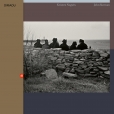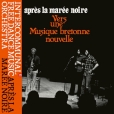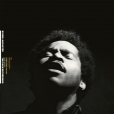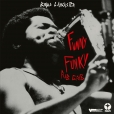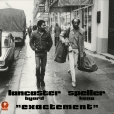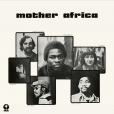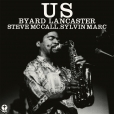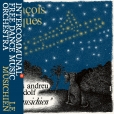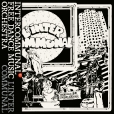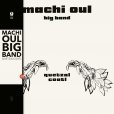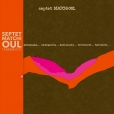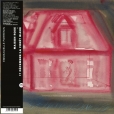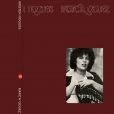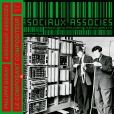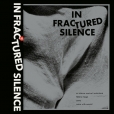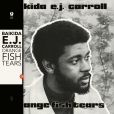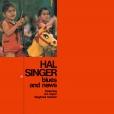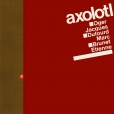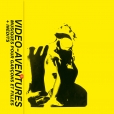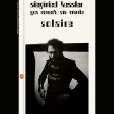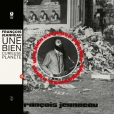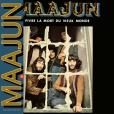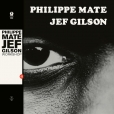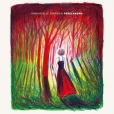Your basket is empty

From 1981, the further excursions of ‘the people’s jazz workshop’, in the words of founder Francois Tusques.
Le Musichien is an Afro-Catalan adventure, free as a bird, headed for the outer spaceways. Tusques sings together with the Spaniard Carlos Andreu, riding the grooving bass-playing of Jean-Jacques Avenel, percussion from Kilikus, the saxophones Sylvain Kassap and Yebga Likoba, and Ramadolf playing trombone.
Les Amis d’Afrique was recorded the following year, at the Tombées de la Nuit festival in Rennes. Tusques and bassist Tanguy Le Doré weave the backdrop of an explosive new brotherhood of breath, in the tradition of John Coltrane and Pharoah Sanders: Bernard Vitet on trumpet, Danièle Dumas and Sylvain Kassap on saxophones, Jean-Louis Le Vallegant and Philippe Le Strat on… yes… cannons.
The Intercommunal Free Dance Music Orchestra was created in 1971 by the legendary pianist François Tusques. L’Inter Communal compiles extracts from concerts given between 1976 and 1978, revelling in the political engagement which lit up free jazz and popular music in that period.
According to Tusques, the Spanish singer Carlos Andreu was a griot ‘who created of new genre of popular song improvised with our music, based on events going on at the time.’
The opener Blues Pour Miguel Enriquez invokes Thelonious Monk in an uproarious homage to the Chilean revolutionary. Another song is entitled L’heure est à la lutte’... The time to fight is now.
“I had to deal personally with my situation as an expatriate, without disavowing it. I tried not to betray my roots, I tried to translate into my music what was essential to me, to reflect my origins — Latin America, its musical and above all human feelings — while remaining faithful to jazz.”
‘Structured free music’, recorded for Palm in January 1975, with producer Jef Gilson at the helm, and the Chilean pianist Manuel Villarroel leading fourteen musicians, including Jef Sicard, François and Jean-Louis Méchali, and Gérard Coppéré, from the earlier Septet formation.
‘From togetherness to dissonance, we dance to Bolerito and shake it up to Leyendas De Nahuelbuta. As for the finale, it is a serpent which is bedazzling and impossible to pin down. To remind ourselves of this, let’s listen to it again.’
Manuel Villarroel left Santiago in September 1970 to participate in the Contemporary Music Workshop in Berlin. He rapidly decided to remain in Europe, to pursue his musical career. The following year, the pianist formed a quartet in Paris with saxophonist Jef Sicard (from the Dharma Quintet to be), adding Gérard Coppéré (saxophone), William Treve (trombone), François Méchali (bass), and Jean-Louis Méchali (drums). With the arrival of Sonny Grey, a Jamaican trumpeter who had collaborated ten years earlier with Daniel Humair, they were ready.
On May 8, 1971, the Septet Matchi-Oul was in the studio for Gérard Terronès’ Futura label. recording seven of Villarroel’s compositions.
Warmly recommended.
Recorded in 1977, the obverse of punk, these are mysterious, gentle songs, simultaneously ancestral and futuristic, occasionally mounting in rhythmic urgency to evoke the Motorik of Faust. (Have a listen to Topaze.) Some were collected by Parrenin in rural communities; others have lyrics by Jean-Claude Vannier, who attended the recording sessions.
The engineer was Bruno Menny — a follower of Xenakis — whose 1972 Cosmographie LP is a landmark in French electroacoustic music. He recorded Parrenin in the converted barn of Jacques Denjean, who worked with Dionne Warwick, Francoise Hardy and the Double Six. (The great Albert Marcoeur recorded two albums there, in Fremontel, Normandy.)
‘If we must risk a few comparisons then Vashti Bunyan, Linda Perhacs, Joanna Newsom, Collie Ryan, Shirley Collins, Trees Community, Sourdeline and Véronique Chalot all spring spontaneously to mind. But this is too reductive for the timeless singularity of Emmanuelle Parrenin.’
The Celtic harpist leading a dozen friends — guitar, piano, violins, flutes, zarb, zither — in spell-binding departures from Breton folk-song, originally released in 1976 but fresh and strange as a vermillion hydrangea in full bloom.
Noguès was to collaborate with Rabih Abou-Khalil, amongst others, but ‘we are reminded here of the Meredith Monk of Greensleeves, there the early albums of Brigitte Fontaine / Areski, elsewhere Emmanuelle Parrenin, Pascal Comelade… Noguès’ poetry is ever-changing: airy (Hunvre), cosmopolitan (Pinvidik Eo Va C’hemener), enigmatic (Ar Bugel Koar), profound (Ar Gemenerez), enchanting (Hirness An Devezhiou). And then there is Marc’h Gouez itself, between nursery rhyme and chamber music, weaving a fabulous, transfixing web. “Brittany equals poetry,” said André… Breton; and Kristen Noguès proves it to be true.’
Lovely stuff; dream-like, captivating; quite different. Check it out.
Encouraged by the Art Ensemble of Chicago, the trumpeter Baikida Carroll upped sticks in 1972, moving from Missouri to Paris. He travelled with several colleagues from the Black Artists Group: saxophonist/flutist Oliver Lake, trombonist Joseph Bowie, drummer Charles ‘Bobo’ Shaw, and trumpeter Floyd LeFlore. Inevitably, they soon crossed paths with Jef Gilson, who invited Carroll to record for his young Palm label, in June 1974. Carroll brought along Lake, and the Franco-Chilean pianist Manuel Villaroel, from the group Matchi-Oul, which had already appeared on Futura in 1971. The lineup was completed by the great Brazilian percussionist Naná Vasconcelos, fresh from the triumph of his own debut LP as leader — the terrific Africadeus, for Saravah.
The first side is knockout: everybody plays a range of percussion and bells on the opener — its own iteration of space jungle love — embedding stately interventions by woodwind and brass; before the wildly funky free-jazz of Forest Scorpio, with raging saxophone and keyboard, and monster groove. The second half is thrillingly hybrid and one-of-a-kind: more reflective, intimate, and spaced-out — increasingly hallucinatory — with an improvisatory feel for dissonance and repetition which beckons Terry Riley and György Ligeti into the mix.
The original Palm artwork is scrupulously reproduced, and an eight-page booklet contains rare and previously unpublished photos. The more expensive LP is from an edition of just 175 copies, with see-through vinyl, and a silk-screened wraparound sleeve, numbered and signed by the artist Stefan Thanneur.
Hotly recommended.
Recorded for Futura in the spring of 1971 — soon after the veteran saxophonist arrived in Paris — with his spar Art Taylor and local musicians including Siegfried Kessler.
Singer came up through numerous swing bands, and then team-ups with bop luminaries like Don Byas and Roy Eldridge, before joining Duke Ellington’s orchestra.
A long look back, blues and news, keenly open to the new thing, this is superb, generous, upful jazz — with dashes of modal, r&b, swing, soul jazz — book-ended by tributes to his time with James Brown. It’s My Thing is JB by way of Cannonball; the limber, extended, new version of Malcolm X, with Kessler whipping up a storm, is simply unmissable.
“I get something out of listening to Coltrane, Shepp and Coleman; I’m really pleased that young players are trying to change things. If they go back to the roots and come up with something new, that’s fantastic.”
Siggy was the piano accompanist of Archie Sheep over several decades; he recorded with Dizzy Reece and Hal Singer.
Here is his key LP as leader, in 1971 — with bassist Gus Nemeth and percussionist Stu Martin — edging from post-Trane into free jazz, with an ear for the contemporary electroacoustic music of Xenakis, Berio and co.
Janneau contributed to François Tusques’ 1965 landmark Free Jazz sessions. He was a stalwart of Jef Gilson’s big band in the years leading up to this first album as leader in 1975, with Jenny-Clark on bass and percussions, Bernard Lubat on drums, and Michel Grailler from Magma on spaced-out synths. The compositions are all FJ originals: check the monumental Droit d’Asile, the spooky Theme For An Unknown Island, and the homage Mr J.C. For Ever.
‘The forerunner of Maajun. Five musicians — Jean-Pierre Arnoux, Cyril and Jean-Louis Lefebvre, Alain Roux and Roger Scaglia — and three times as many instruments at the service of electric-poetic, guerrilla folk and blues, which evokes the fantasy coming-together of Frank Zappa and Jacques Higelin, Sonny Sharrock and the Art Ensemble Of Chicago.’
Previously unreleased recordings from 1978, 1981 and 1982, conceived for choreographers. The bandoneon-playing of the Argentinian Juan Mosalini, electric piano by Jacques Denjean, electroacoustics by Bruno Menny and Didier Malherbe from Gong are swirled into a mix of spinet dulcimer, flute, hurdy-gurdy and other-worldly singing (amongst other ingredients), all steeped in the sonic atmosphere of a vintage acid-folk freak-out.

